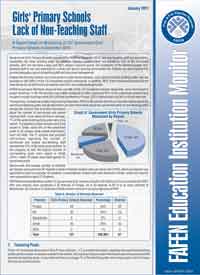ISLAMABAD, January 31, 2011: The physical infrastructure of state-run dispensaries needs urgent attention of government as buildings of more than 37% of 111 dispensaries, monitored by FAFEN during the month of December were in dilapidated condition.
According to monthly FAFEN Health Institution Monitor, released here Monday, more than one fourth (26%) of the monitored dispensaries nationwide were found to be without boundary walls. In addition, 46% of the facilities did not have clean drinking water arrangements and 44% did not have washrooms (with running water) for patients. Basic equipment like sterilizers and syringe cutters were also absent in a number of dispensaries monitored in December. Only 39% had working sterilizers for sterilizing medical equipment and 65% had syringe cutters.
FAFEN Governance Monitors visited 111 dispensaries in 75 districts nationwide during the month of December. Forty five dispensaries were monitored in 27 districts of Punjab, 33 in 22 districts of Sindh, 27 in 20 districts of KP, four in as many districts of Balochistan, and one each in ICT and FATA.
The lack of basic infrastructure and equipment at dispensaries can be attributed in part to weak oversight by government and elected representatives. In a span of three months, only 56 visits were made by government officials and elected representatives (49 by government officials and only seven by elected representatives) to the monitored dispensaries. The most neglect was seen on part of elected representatives who made seven visits during the three-month period. This includes three visits by MPAs (two to Punjab and one to KP), one by an MNA (to Punjab), and three by other elected representatives (to Punjab).
Unlike conditions of physical infrastructure and availability of basic equipment, observation results revealed that a good 91% of the 111 dispensaries had adequate stock of medicines. Furthermore, medicines were available free of cost in 90% of the dispensaries monitored in 75 districts of the country.
The management of many dispensaries did not share information about the sanctioned posts of doctors, nurses, sanitary workers and peon/watchman during December 2010. Only 64 of the 111 dispensaries monitored nationwide provided information with regard to sanctioned posts of doctors. Patients at 17% of these 64 dispensaries where doctors were appointed complained regarding unavailability of doctors. This was despite the fact that a high occupancy rate of 96% (76 doctors appointed against 79 sanctioned posts) was recorded at these 64 Dispensaries.
Likewise, patients at 9% of the 67 Dispensaries that provided information about appointment of nurses complained that nurses were not present on duty, in spite of 100% occupancy rates at these 67 dispensaries. Out of 111 dispensaries only 53 provided information about the occupied posts of sanitary workers and 89 about appointment of peon/watchman. Occupancy rate at these dispensaries was above 95%.
To download complete report, click here




